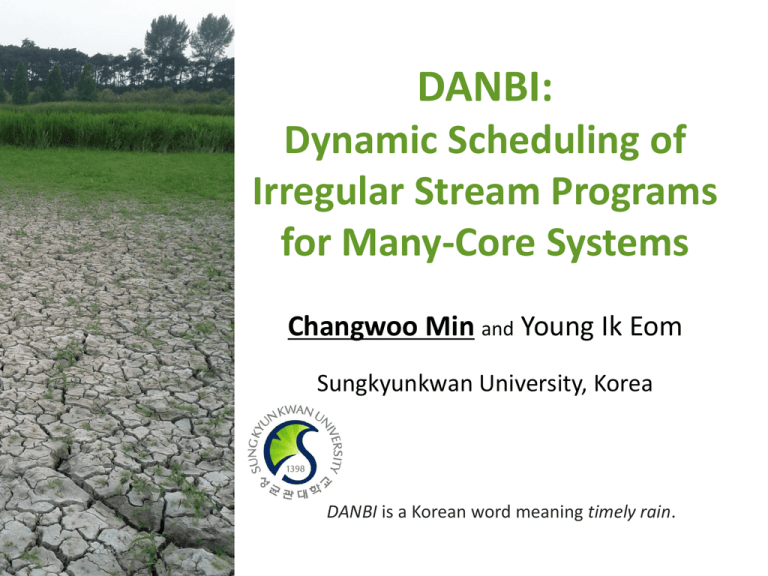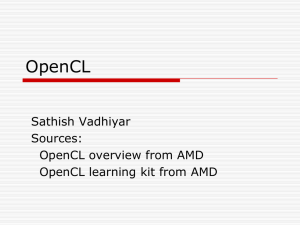Dynamic Scheduling of Irregular Stream Programs for Many
advertisement

DANBI:
Dynamic Scheduling of
Irregular Stream Programs
for Many-Core Systems
Changwoo Min and Young Ik Eom
Sungkyunkwan University, Korea
DANBI is a Korean word meaning timely rain.
What does Multi-Cores
mean to Average Programmers?
1. In the past, hardware was mainly responsible for
improving application performance.
1. Now, in multicore era, performance burden falls on
programmers.
1. However, developing a parallel software is getting
more difficult.
–
Architectural Diversity
•
Complex memory hierarchy, heterogeneous cores, etc.
Parallel Programming Models and Runtimes
e.g., OpenMP, OpenCL, TBB, Cilk, StreamIt, …
2
Stream Programming Model
• A program is modeled as a graph of
computing kernels communicated via FIFO
queue.
Data
Parallelism
– Producer-consumer relationships are expressed in
the stream graph.
Consumer Kernel
Producer Kernel
Task
Parallelism
FIFO Queue
• Task, data and pipeline parallelism
• Heavily researched on various architectures
and systems
Pipeline
Parallelism
– SMP Core, Tilera, CellBE, GPGPU, Distributed
System
3
Research Focus:
Static Scheduling of Regular Programs
Scheduling & Execution
Compiler
1. Estimate work for
each kernel
Runtime
3. Iteratively execute the
schedules with barrier
synchronization
2. Generate optimized
schedules based on
the estimation
Programming Model
•
Input/output data rates
should be known at compile
time.
•
Cyclic graphs with feedback
loops are not allowed
1:3
1:1
1:2
Barrier |
Core | 1 2
3
• BUT, replying on the accuracy of the
performance estimation load imbalance
• Accurate work estimation is difficult or
barely possible in many architectures.
• BUT, many interesting problem domains are
irregular with dynamic input/output rates
and feedback loops.
• Computer graphics, big data analysis, etc.
4
How does the load imbalance matter?
• Scalability of StreamIt programs on a 40-core systems
– 40-core x86 server
– Two StreamIt applications: TDE and FMRadio
• No data-dependent control flow
Perfectly balanced static schedule
Ideal speedup!?
<TDE>
<FMRadio>
• Load imbalance does matter even on the perfectly balanced schedules.
– Performance variability of an architecture
• Cache miss, memory location, SMT, DVFS, etc.
– For example, core-to-core memory bandwidth shows 1.5 ~ 4.3x difference even
in commodity x86 servers. [Hager et al., ISC’12]
5
Any dynamic scheduling
mechanisms?
• Yes, but they are insufficient:
– Restrictions on the supported types of stream programs
• SKIR [Fifield, U. of Colorado dissertation]
• FlexibleFilters [Collins et al., EMSOFT’09]
– Partially perform dynamic scheduling
• Borealis [Abadi et al., CIDR’09]
• Elastic Operators [Schneider et al., IPDPS’09]
– Limit the expressive power by giving up the sequential
semantics
• GRAMPS [Sugerman et al., TOG’09] [Sanchez et al., PACT’11]
• See the details on the paper.
6
DANBI Research Goal
Static Scheduling of Regular Streaming Applications
Dynamic Scheduling of Irregular Streaming Applications
1. Broaden the supported application domain
1. Scalable runtime to cope with the load imbalance
7
Outline
•
•
•
•
•
Introduction
DANBI Programming Model
DANBI Runtime
Evaluation
Conclusion
8
DANBI Programming Model in a Nutshell
Test Source
Sequential
Sort
Split
Merge
Test Sink
< DANBI Merge Sort Graph >
• Computation Kernel
– Sequential or Parallel Kernel
• Data Queues with reserve-commit semantics
– push/pop/peek operations
– A part of the data queue is first reserved for
exclusive access, and then committed to notify
when exclusive use ends.
– Commit operations are totally ordered according
to the reserve operations.
• Supporting Irregular Stream Programs
– Dynamic input/output ratio
– Cyclic graph with feedback loop
• Ticket Synchronization for Data Ordering
– Enforcing the ordering of the queue operations for
a parallel kernel in accordance with DANBI
scheduler.
– For example, a ticket is issued at pop and only
thread with the matching ticket is served for push.
Issuing a ticket
at pop()
Serving a ticket
at push()
9
Calculating Moving Averages
in DANBI
01 __parallel
02 void moving_average(q **in_qs, q **out_qs, rob **robs) {
q *in_q = in_qs[0], *out_q = out_qs[0];
03
ticket_desc td = {.issuer=in_q, .server=out_q};
04
rob *size_rob = robs[0];
05
int N = *(int *)get_rob_element(size_rob, 0);
06
q_accessor *qa;
07
float avg = 0;
08
09
qa = reserve_peek_pop(in_q, N, 1, &td);
10
for (int i = 0; i < N; ++i)
11
avg += *(float *)get_q_element(qa, i);
12
avg /= N;
13
commit_peek_pop(qa);
14
15
qa = reserve_push(out_q, 1, &td);
16
*(float *)get_q_element(qa, 0) = avg;
17
commit_push(qa);
18
19 }
in_q
ticket issuer
moving_average()
for (int i = 0; i <
moving_average()
N; ++i)
for (int i = 0; i <
avg += …
moving_average()
N;
++i) < N; ++i)
for (int i = 0; iavg
/= N;
avg += …avg += …
avg /= N;
avg /= N;
ticket server
out_q
10
Outline
•
•
•
•
•
Introduction
DANBI Programming Model
DANBI Runtime
Evaluation
Conclusion
11
Overall Architecture of DANBI Runtime
DANBI
Program
DANBI
Runtime
Q1
K1
Per-Kernel
Ready Queue
Running
User-level Thread
Dynamic
Load-balancing
Scheduler
Q2
K2
Q3
K3
K4
Scheduling
1. When to schedule?
2. To where?
•
•
Dynamic Load-balancing Scheduling
No work estimation
Use queue occupancies of a kernel.
K1K2
K3K2
K2K2
DANBI
Scheduler
DANBI
Scheduler
DANBI
Scheduler
OS
Native
Thread
Native
Thread
Native
Thread
HW
CPU 0
CPU 1
CPU 2
12
Dynamic Load-Balancing Scheduling
empty
wait
full or wait
wait
01 __parallel
02 void moving_average(q **in_qs, q **out_qs, rob **robs) {
q *in_q = in_qs[0], *out_q = out_qs[0];
03
ticket_desc td = {.issuer=in_q, .server=out_q};
04
rob *size_rob = robs[0];
05
int N = *(int *)get_rob_element(size_rob, 0);
06
q_accessor *qa;
07
float avg = 0;
08
09
qa = reserve_peek_pop(in_q, N, 1, &td);
10
for (int i = 0; i < N; ++i)
11
avg += *(float *)get_q_element(qa, i);
12
avg
/= N;
13
commit_peek_pop(qa);
14
15
qa = reserve_push(out_q, 1, &td);
16
*(float *)get_q_element(qa, 0) = avg;
17
commit_push(qa);
18
19 }
When a queue operation is
blocked by queue event, decide
where to schedule.
At the end of thread execution, decide whether
to keep running the same kernel or schedule
elsewhere.
QES
PSS
PRS
Queue Event-based
Scheduling
Probabilistic
Speculative Scheduling
Probabilistic Random
Scheduling
13
Queue Event-based Scheduling (QES)
DANBI
Program
DANBI
Runtime
K1
Q1
K2
Q2
K3
Q3
K4
Per-Kernel
Ready Queue
Running
User-level Thread
Dynamic
Load-balancing
Scheduler
Q1 is full.
K1K2
DANBI
Scheduler
Q2 is empty.
K3K2
DANBI
Scheduler
WAIT
K2K2
DANBI
Scheduler
• Scheduling Rule
– full consumer
– empty producer
– waiting another thread instance of the same kernel
• Life Cycle Management of User-Level Thread
– Creating and destroying user-level threads if needed.
14
Thundering-Herd Problem in QES
EMPTY
FULL
Qx
Ki-1
Qx+1
Ki
x12
Ki+1
x12
High contention on Qx and ready queues of Ki-1 and Ki!!!
The Thundering-herd Problem
Key insight:
Prefer pipeline parallelism than data parallelism.
Qx
Ki-1
x4
Qx+1
Ki
x4
Ki+1
x4
15
Probabilistic Speculative Scheduling (PSS)
• Transition Probability to Consumer of its Output Queue
– Determined by how much the output queue is filled.
• Transition Probability to Producer of its Input Queue
– Determined by how empty the input queue is.
Ki-1
Qx
Qx+1
Ki
Pi,i-1 = 1-Fx
Ki+1
Pi,i+1 = Fx+1
Pi-1,i = Fx
Fx: occupancy of Qx.
Pi+1,i = 1-Fx+1
Pbi,i-1 = max(Pi,i-1-Pi-1,i,0)
Pbi,i+1 = max(Pi,i+1-Pi+1,i,0)
Pbi,i-1 or Pbi,i+1
Pti,i-1 = 0.5*Pbi,i-1
Pt
i,i
=
1-Pt
t
i,i-1-P i,i+1
Pti,i+1 = 0.5*Pbi,i+1
Pti,i+1: transaction
probability from Ki to Ki+1
• Steady state with no transition
• Pti,i = 1, Pti,i-1 = Pti,i+1 = 0 Fx = Fx+1 = 0.5 double buffering
16
Ticket Synchronization and Stall Cycles
Input queue
f(x)
• If f(x) takes almost the same
amount of time
Thread 1
pop
f(x)
push
Output queue
• Otherwise
Due to
• Architectural Variability
• Data dependent control
flow
Thread 1
pop
Thread 2
pop
pop
Thread 3
f(x)
pop
push
f(x)
push
Thread 2
Thread 4
f(x)
f(x)
push
pop
f(x)
pop
f(x)
Thread 3
stall
stall
push
push
Thread 4
pop
f(x)
stall
push
push
Very few stall cycles
Very large stall cycles!!!
Key insight:
Schedule less number of threads for the kernel
which incurs large stall cycles.
17
Probabilistic Random Scheduling (PRS)
• When PSS is not taken, a randomly selected
kernel is probabilistically scheduled if stall cycles
of a thread is too long.
– Pri = min(Ti/C, 1)
• Pri : PRS probability, Ti : stall cycles, C: large constant
Thread 1
Thread 1
pop
f(x)
pop
Thread 2
pop
Thread 3
f(x)
pop
f(x)
stall
stall
push
push
Thread 4
f(x)
Thread 2
pop
Thread 3
f(x)
pop
f(x)
pop
f(x)
stall
push
push
stall
stall
push
push
Thread 4
pop
f(x)
stall
push
push
18
Summary of
Dynamic Load-balancing Scheduling
When a queue operation is
WHEN blocked by queue event,
decide where to schedule.
POLICY
At the end of thread execution, decide whether to
keep running the same kernel or schedule
elsewhere.
QES
PSS
PRS
Queue Event-based
Scheduling
Probabilistic Speculative
Scheduling
Probabilistic Random
Scheduling
Queue Event
: Full, Empty, Wait
Queue Occupancy
Stall Cycles
Naturally use producer- Prefer pipeline
Cope with fine grained
consumer relationships parallelism than data
load-imbalance.
in the graph.
parallelism to avoid the
thundering herd
problem.
19
Outline
•
•
•
•
•
Introduction
DANBI Programming Model
DANBI Runtime
Evaluation
Conclusion
20
Evaluation Environment
• Machine, OS, and Tool chain
– 10-core Intel Xeon Processor * 4 = 40 cores in total
– 64-bit Linux kernel 3.2.0
– GCC 4.6.3
• DANBI Benchmark Suite
– Port benchmarks from StreamIt, Cilk, and OpenCL to DANBI
– To evaluate the maximum scalability, we set queue sizes to
maximally exploit data parallelism (i.e., for all 40 threads to
work on a queue.)
Origin
Benchmark
Description
Kernel
Queue
Remarks
StreamIt
FilterBank
Multirate signal processing filters
44
58
Complex pipeline
StreamIt
FMRadio
FM Radio with equalizer
17
27
Complex pipeline
StreamIt
FFT2
64 elements FFT
4
3
Mem. intensive
StreamIt
TDE
Time delay equalizer for GMTI
29
28
Mem. intensive
Cilk
MergeSort
Merge sort
5
9
Recursion
OpenCL
RG
Recursive Gaussian image filter
6
5
OpenCL
SRAD
Diffusion filter for ultrasonic image
6
6
21
DANBI Benchmark Graphs
FilterBank
FMRadio
FFT2
TDE
StreamIt
Cilk
OpenCL
MergeSort
RG
SRAD
03SplitK
22
DANBI Scalability
25.3x
(a) Random Work Stealing
30.8x
(c) QES + PSS
28.9x
(b) QES
33.7x
(d) QES + PSS + PRS
23
Random Work Stealing vs. QES
25.3x
(a) Random Work Stealing
28.9x
(b) QES
• Random Work Stealing
– Good scalability for compute
intensive benchmarks
– Bad scalability for memory
intensive benchmarks
– Large stall cycles Larger
scheduler and queue operation
overhead
• QES
– Smaller stall cycles
• MergeSort: 19% 13.8%
• RG: 24.8% 13.3%
– Thundering-herd problem
• Queue operations of RG is
rather increased.
W: Random Work Stealing, Q: QES
24
core
RG
Graph
Transpose1
Recursive
Gaussian2
Test Sink
Transpose2
40
35
30
25
20
15
10
5
0
Stall
Cycles
Random
Work
Stealing
0
core
Recursive
Gaussian1
Test Source
1
2
3
4
5
6
7
8
9
10
time (seconds)
11
12
40
35
30
25
20
15
10
5
0
13
14
15
16
17
18
14
15
16
17
18
QES
0
1
2
3
4
5
6
7
8
9
10
time (seconds)
11
12
13
Thundering herd problem
High degree of data parallelism
High contention on shared data structures, data queues and ready queues.
High likelihood of stall caused by ticket synchronization.
25
QES vs. QES + PSS
28.9x
(b) QES
30.8x
(c) QES + PSS
• QES + PSS
– PSS effectively avoids the
thundering-herd problem.
– Reduces the fractions of
queue operation and stall
cycle.
• RG: Queue ops: 51%
14%, Stall: 13.3% 0.03%
– Marginal performance
improvement of
MergeSort:
• Short pipeline little
opportunity for pipeline
parallelism
Q: QES, S: PSS
26
RG
Graph
Recursive
Gaussian1
Test Source
Transpose1
Recursive
Gaussian2
Test Sink
Transpose2
Stall
Cycles
core
Random
Work
Stealing
40
35
30
25
20
15
10
5
0
QES
core
0
1
2
3
4
5
6
40
35
30
25
20
15
10
5
0
7
8
9
10
time (seconds)
11
12
13
14
15
16
17
18
11
12
13
14
15
16
17
18
QES + PSS
0
1
2
3
4
5
6
7
8
9
10
time (seconds)
27
QES + PSS vs. QES + PSS + PRS
30.8x
33.7x
• QES + PSS + PRS
– Data dependent
control flow
• MergeSort: 19.2x 23x
(c) QES + PSS
(d) QES + PSS + PRS
– Memory Intensive
benchmarks:
NUMA/shared cache
• TDE: 23.6 30.2x
• FFT2: 30.5 34.6x
S: PSS, R: PRS
28
RG
Graph
Recursive
Gaussian1
Test Source
Transpose1
Recursive
Gaussian2
Test Sink
Transpose2
Stall
Cycles
Random
Work
Stealing
core
QES
40
35
30
25
20
15
10
5
0
QES + PSS
core
0
1
2
3
4
5
6
40
35
30
25
20
15
10
5
0
7
8
9
10
time (seconds)
11
12
13
14
15
16
17
18
11
12
13
14
15
16
17
18
QES + PSS + PRS
0
1
2
3
4
5
6
7
8
9
10
time (seconds)
29
Comparison with StreamIt
OS Kernel
60%
40%
20%
FFT2
TDE
MergeSort
RG
OpenCL
DANBI
OpenCL
DANBI
Cilk
DANBI
StreamIt
DANBI
StreamIt
DANBI
StreamIt
DANBI
StreamIt
0%
FilterBank FMRadio
< DANBI: QES+PSS+PRS >
Runtime
80%
DANBI
12.8x
Exec. Time Breakdown
35.6x
Application
100%
SRAD
< Other Runtimes >
• Latest StreamIt code with highest optimization option
– Latest MIT SVN Repo. , SMP backend (-O2), gcc (-O3)
• No runtime scheduling overhead
– But, suboptimal schedules incurred by inaccurate
performance estimation result in large stall cycles.
• Stall cycle at 40-core
– StreamIt vs. DANBI = 55% vs. 2.3%
30
Comparison with Cilk
OS Kernel
60%
40%
20%
FFT2
TDE
MergeSort
RG
OpenCL
DANBI
OpenCL
DANBI
Cilk
DANBI
StreamIt
DANBI
StreamIt
DANBI
StreamIt
DANBI
0%
FilterBank FMRadio
< DANBI: QES+PSS+PRS >
Runtime
80%
DANBI
11.5x
StreamIt
23.0x
Exec. Time Breakdown
Application
100%
SRAD
< Other Runtimes >
• Intel Cilk Plus Runtime
• In small number of cores, Cilk outperforms DANBI.
– One additional memory copy in DANBI for rearranging data for parallel
merging has the overhead.
• The scalability is saturated at 10 cores and starts to degrade at 20
cores.
– Contention on work stealing causes disproportional growth of OS
kernel time since Cilk scheduler voluntarily sleeps when it fails to steal
a work from victim’s queue.
• 10 : 20 : 30 : 40 cores = 57.7% : 72.8% : 83.1% : 88.7%
31
Comparison with OpenCL
OS Kernel
60%
40%
20%
FFT2
TDE
MergeSort
RG
OpenCL
DANBI
OpenCL
DANBI
Cilk
DANBI
StreamIt
DANBI
StreamIt
DANBI
StreamIt
DANBI
0%
FilterBank FMRadio
< DANBI: QES+PSS+PRS >
Runtime
80%
StreamIt
14.4x
DANBI
35.5x
Exec. Time Breakdown
Application
100%
SRAD
< Other Runtimes >
• Intel OpenCL Runtime
• As core count increases, the fraction of runtime
rapidly increases.
– More than 50% of the runtime was spent in the work
stealing scheduler of TBB, which is an underlying
framework of Intel OpenCL runtime.
32
Outline
•
•
•
•
•
Introduction
DANBI Programming Model
DANBI Runtime
Evaluation
Conclusion
33
Conclusion
• DANBI Programming Model
– Irregular stream programs
• Dynamic input/output rates
• A cyclic graph with feedback data queues
• Ticket synchronization for data ordering
• DANBI Runtime
– Dynamic Load-balancing Scheduling
• QES: use producer-consumer relationships
• PSS: prefer pipeline parallelism than data parallelism to avoid the
thundering herd problem
• PRS: to cope with fine grained load-imbalance
• Evaluation
– Almost linear speedup up to 40 cores
– Outperforms state-of-the-art parallel runtimes
• StreamIt by 2.8x, Cilk by 2x, Intel OpenCL by 2.5x
34
DANBI
\\\
THANK YOU!
QUESTIONS?
35





